
More than 180 years after the Northeast began its journey to becoming synonymous with tea, coffee is demanding space on those verdant hill slopes
There’s an aroma of Brazil in Haflong, Assam’s only hill station 1,000 metres above sea level. It has much to do with a café in a two-storeyed cottage named after soccer legend Pele.
Nibila Jidung set up Pele Coffee Shop in the town’s Gadain Raji locality in 2020. The shop is named as much after the Brazilian football star as Jidung’s deceased son, who was born the day Pele landed in Kolkata in September 1977 to play a friendly match for New York Cosmos versus Mohun Bagan. And, as in Brazil, the coffee she serves is home-grown.
In just two years, the café has become a popular hangout for the young in Haflong. Its success, however, began with a big failure more than two decades ago.
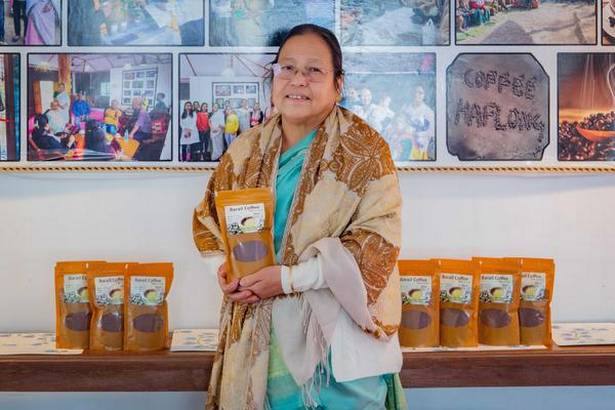
In the 1990s, the Assam Plantation Crops Development Corporation Ltd had started a coffee plantation on a large area leased from Disagisim village near Haflong, and then handed it back to the villagers to give them a source of income. But the plantation soon fell into disuse; the people were not used to growing coffee as a staple. But when Jidung’s late husband Prahlad Chandra Jidung retired, his family decided to lease the plantation in 1999 and started employing local hands. “This helped us generate some income and provide livelihood to the people of the village,” says Jidung, 65. But the plantation area reduced from 100 bighas to 25 over time, for several reasons.
First, of course, the Jidungs faced worker shortage during a decade of extremism. Another problem was the loss of quality — the delay in transporting the cherry to the auction centre in Bengaluru resulted in a lower price for their coffee beans. “The Coffee Board would take the cherries from us, keep them in a warehouse in Haflong, then transport them for auction in Bengaluru.”
When Jidung’s son died in 2015, she realised her coffee business was going nowhere. “It was around that time that the Coffee Board advised me to create my own brand and open an outlet to promote local consumption,” she says.
Schooled for success
The board helped her procure the equipment to process freshly-plucked coffee: machinery to do everything from removing the shell of the fruit, drying the coffee bean, and hulling (crunching off the parchment skin of the bean) to roasting and grinding. The effort has been worth it; people are developing a taste for her brand, Barail Coffee, in two forms — filter coffee and cold coffee. Her brand is a mix of the Robusta she grows and Arabica from the coffee garden of Sehahohen Eanlhou at Changpijang village about 25 km away.
Jidung is one of a few people in the Northeast who grows, roasts, grinds and brews her own brand of coffee from an annual yield of about 2,500 kg. Lichan Humtsoe, her counterpart in Nagaland’s capital Kohima, has taken a similar venture to a different level. A fashion photographer-turned-beverage entrepreneur, Humtsoe is the founder of Été Coffee. Été in the Lotha Naga dialect means ‘us’ or ‘ours’ and the branding, he says, reflects the diversity of the multi-tribe Naga community as well as the multiple flavours of the coffee sourced from different districts of Nagaland.
Été Coffee dabbles in everything but farming. It has a full-fledged roastery and production unit, retail line, two coffee breweries, consultancy services, a coffee school, three observation farms, two nursery units, coffee laboratory services and an upcoming e-commerce space.“We established Été in 2016 as the first specialty coffee roasting company in the Northeast. It was around that time the third wave of the coffee movement of the 1990s had created a new focus on specialty coffees that were offering a range of aromas and tastes. We subsequently opened the first coffee school in the region to provide eight courses on coffee-related services,” he says. Thanks to the school and consultancy services, Humtsoe’s firm has been able to establish more than 10 coffee shops across Nagaland and train and deploy baristas in several other cafes.
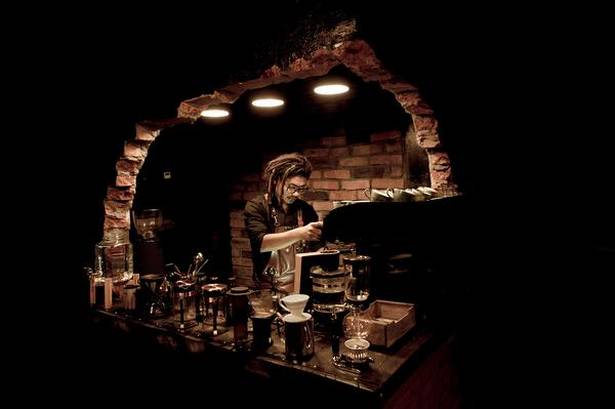
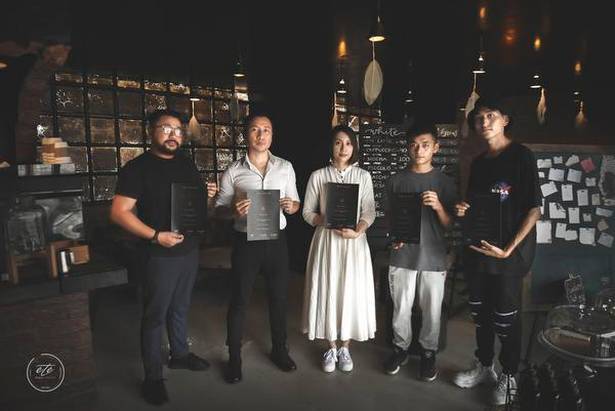
Farmers and growers across Nagaland are at the core of the Été Coffee enterprise. “Farmers form an integral part of the coffee industry and deserve their share of the benefits. Our EML (educate, motivate and lead) network provides a safety net against any form of exploitation and ensures that the resources are optimised, not exploited,” says Humtsoe. His venture coincided with the revival of coffee farming in Nagaland. The Nagaland Plantation Crop Corporation had also undertaken extensive coffee plantations in the 1980s with inputs from the Coffee Board, but the initiative could not be sustained because of transportation and marketing issues, and the corporation was disbanded. In 2015-16, the State’s Land Resource Department was given the responsibility of bringing coffee back to the table.
Says the department’s director, Renben Jami: “We studied the potential of coffee afresh, and realised 10 lakh hectares can be used for it across the State. But we are focussing on 50,000 ha now, with plantations currently covering 12,000 ha. “We are acting as a bridge between farmers and buyers, who are lining up from abroad and elsewhere in the country.” .
Single-estate varieties
The primary buyer of coffee grown in Nagaland is Pieter Vermeulen based in South Africa’s Cape Town.

He exports the Naga Coffee brand of several single-estate varieties. He came to know about the coffee in Nagaland after his farming venture in Nepal met with a bovine end; cows that roamed about the villages devoured most of the 20,000 coffee shrubs he had planted. He signed an agreement with the Nagaland government in 2015 to provide logistical support, training and seedlings to subsistence farmers, and helped them market their coffee. “We were not able to export for two years due to the COVID-19 restrictions but we expect our first harvest of 40 metric tonnes this year,” he says. “The challenge now is to bring coffee in the region at par with international standards,” says Vermeulen.
According to Humtsoe, the organically-grown local coffee, with research having gone into varietals and soil quality, is on par with the best in the world. The coffee grown here has a ‘wild’ flavour, induced by the other plants that are grown alongside, and this gives it an edge over coffee grown elsewhere, says Jubanylla G. Bang, product head of Zizira, a farmer-driven company based in Meghalaya’s capital, Shillong. The estate sells ‘7000 Steps Coffee’, so named because of the number of steps one has to climb to reach Mynriah in the East Khasi Hills district where some of the coffee is grown.
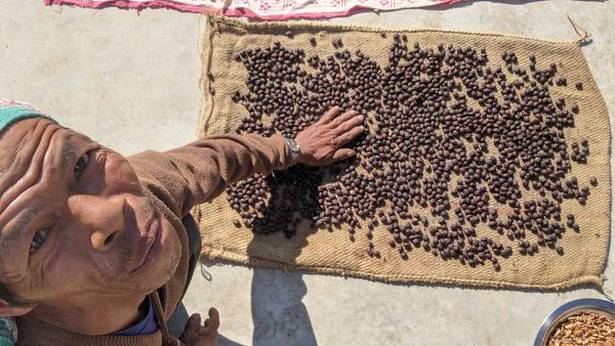
Rashi Vaswani runs two Bread Café outlets in Shillong. “We depended on coffee imported from southern India when we started out 12 years ago. About four years ago, we switched to local varieties and they have turned out to be just as good,” she says. “Packaged smartly, the local coffee flies off our shelves.” Her supplier is Smoky Falls Coffee Tribe, the first coffee roaster of Meghalaya.
Arabica over Camellia?
A Sufi saint named Baba Budan is credited with having brought coffee to India in the 16th century. But the beverage actually gained popularity in the 19th century in colonial settlements, and the earliest farming in the Northeast is mentioned in a 1908 book titled Coffee Cultivation in Khasi Hills (in Meghalaya, then a part of Assam). This was about eight decades after the first commercial tea plantation came up in eastern Assam’s Chabua.
Synonymous with tea, Assam today has 3,37,690.35 ha under tea plantation with an annual production of 626.23 million kilos. Tea is also grown in the other six contiguous States of the Northeast, together accounting for some 25 million kilos more.
Since the Coffee Board’s initiatives in the 1980s, the total coffee planted area in the Northeast is 4,618.26 ha, with 1,394.21 ha of coffee-bearing area yielding an average annual 150 metric tonnes of clean coffee.
Bidyananda Borkakoty, advisor to the North Eastern Tea Association, does not think coffee can become a threat to tea. “About 70% of coffee in India is grown in Karnataka, but many popular tea boutiques or lounges have also come up in Bengaluru in the last five years,” he points out. Coffee Board officials say the push for coffee in Assam since 1976 was never intended to give tea competition: for one, coffee is grown in areas above 500 metres altitude while tea in Assam thrives below 100 metres; and two, coffee cultivation in the Northeast is primarily pursued by tribal people.
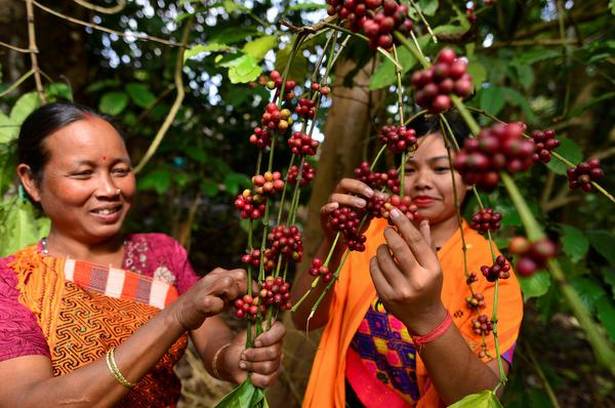
Coffee Board’s joint director (extension) for the Northeast, Navin K.B. Ryntathiang, says the board’s extension personnel collect the coffee produced by the tribal growers and take it for processing and auctioning. “Besides the decentralisation, we have been providing subsidy and research support to farmers and brewers to pursue their own branding and marketing,” he says. The support system includes coffee processing and curing facilities and a 25 ha regional coffee research station in Central Assam’s Diphu.
Officials involved in promoting coffee, in fact, attribute their strategy to that adopted by the tea industry. “Our department is setting up coffee bars across Nagaland, deviating from the earlier theory of growing coffee for export alone. India has a huge captive coffee market that needs tapping into, and the tea industry has taught us how this market can help us sustain,” says Jami. Humtsoe says the coffee culture is growing exponentially in Nagaland and elsewhere in the Northeast, but the supply from local farms is way below the demand. “In 2021, we ran out of the 15 tonnes we procured in no time. We hope we get more than the 30 tonnes we expect to sell this year,” says Zizira’s Bang.
Equally, the growing demand is making smaller farmers on Assam’s hills create space for coffee in their holdings that grow ginger, black pepper, long pepper and broomstick grass. “I started growing coffee on one bigha last year with seeds and training provided by the Coffee Board. I am prepared to wait three years for the shrubs to yield fruit and five years for commercial harvesting,” says Litha Kholar of Umswai in central Assam’s West Karbi Anglong district.
source: http://www.thehindu.com / The Hindu / Home> Society> New Brew / by Rahul Karmakar / January 22nd, 2022

